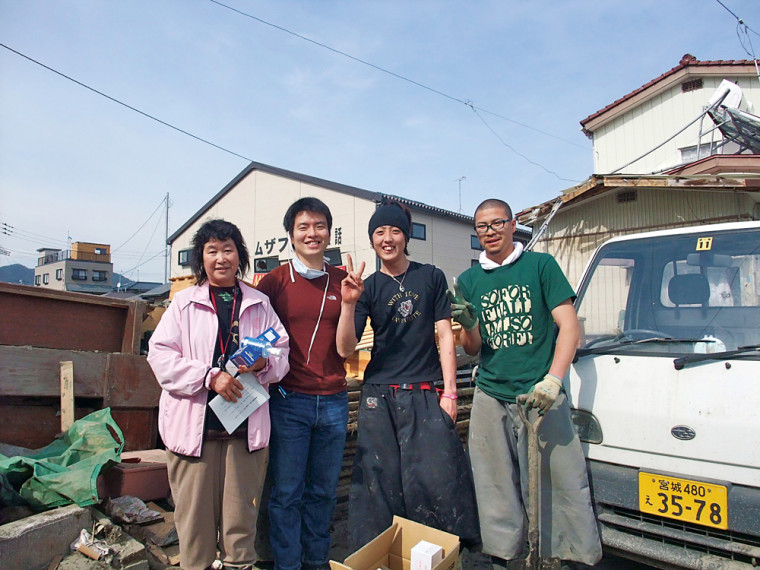Helping to Heal Post-Quake Japan
Open gallery

After the earth rumbled, a massive wave roared over cities and towns. Sirens blared, and people living on Japan’s eastern coast scrambled to higher ground. In the northeastern city of Kesennuma, three generations of a local family piled into their car but got stuck in traffic going uphill. Seeing the tsunami rising behind them, they abandoned their car and ran. Their toddler stumbled, and a kind stranger swooped her up and carried her. The family’s grandfather, who was incapacitated from advanced Parkinson’s disease, stayed behind in a second-floor bedroom. Submerged to the waist in cold seawater, he spent the night trying to stay awake and stave off hypothermia. A helicopter evacuated him the next day.
“Many people we met had similar stories,” says Dr. Makoto Uchiyama BA ’04, who volunteered in post-quake Japan. “We did our best to listen and help.”
It looked like an imaginary line had drawn between destruction and normalcy—the point where the tidal wave had advanced and then lost power and receded. Makoto Uchiyama BA ’04
Although he was born in Bangkok, grew up in Malaysia, and had never lived in Japan, Uchiyama considers Japan his homeland, his native culture. As a resident physician in Portland’s Legacy Health System, he felt compelled to put his medical training to use on the ground after a 9.0-magnitude earthquake hit on March 11. The subsequent tsunami, fires, and nuclear threat confirmed his resolve.
“I was prepared to ask for a monthlong leave from my residency program with plans to graduate late,” says Uchiyama. “My program director suggested I design the trip as a medical rotation. I’m grateful for Legacy’s support and flexibility.”
Partnering with the Japan Primary Care Association, Uchiyama flew to Tokyo on March 27. He manned the group’s headquarters, filtering information from numerous disaster sites, then set out for Kesennuma.
Once there, he encountered battered ships stranded in the middle of the road, piles of rubble, and waterlogged cars. The smell of stagnant seawater and rotting debris hung in the air. “It looked like an imaginary line had drawn between destruction and normalcy—the point where the tidal wave had advanced and then lost power and receded,” he says.
Forty percent of Kesennuma’s 26,000 homes were submerged or damaged by water. Of the 73,000 residents, 2,000 died and 7,000 were evacuated.
Because I was able to stay longer than most volunteers, my main job was coordinating care, allocating medical and human resources. I also monitored my colleagues for signs of excess stress.Makoto Uchiyama BA ’04
Uchiyama worked at a shelter located in the city’s elementary and middle school, undamaged on a hilltop overlooking the Bay of Kesennuma. One of 70 shelters, it was established by a local primary care physician who had lost his own home and clinic.
“Because I was able to stay longer than most volunteers, my main job was coordinating care, allocating medical and human resources,” says Uchiyama. “I also monitored my colleagues for signs of excess stress.”
While in Kesennuma, he joined an outreach team, knocking on doors to see if survivors needed medical supplies, equipment, or intervention. The elderly were particularly vulnerable.
Infectious disease management was a high priority, with an emphasis on influenza and viral gastroenteritis. Upper respiratory symptoms were common as well, as were acute insomnia and other stress-related symptoms. The team also treated chronic diseases like hypertension, reactive airway disease, and diabetes.
In mid-April, Uchiyama returned home to Portland, to a residency rotation in critical care (his desired specialty) and to his wife, Hitomi, and his infant daughter, Lino.
“As a husband and father, I could never have left without the support and encouragement of my wife,” he says. “She knows me very well.”
Reflecting on his work in Japan, Uchiyama is determined to become a better leader and a physician who treats the whole person—providing support and comfort in mindful, spiritual, and scientific ways.
“When the city of Kesennuma was devastated and the community turned upside down, the great leaders brought stability and a sense of purpose,” he says. “They helped us find meaning in disaster.”
—by Pattie Pace
More L&C Magazine Stories
Lewis & Clark Magazine is located in McAfee on the Undergraduate Campus.
MSC: 19
email magazine@lclark.edu
voice 503-768-7970
fax 503-768-7969
The L&C Magazine staff welcomes letters and emails from readers about topics covered in the magazine. Correspondence must include your name and location and may be edited.
Lewis & Clark Magazine
Lewis & Clark
615 S. Palatine Hill Road MSC 19
Portland OR 97219

